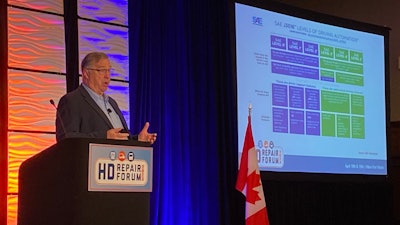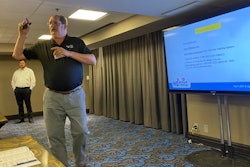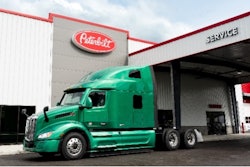
After touching on the components used within advanced driver assistance systems (ADAS) Tuesday, the second day at the HD Repair Forum kicked off by addressing the impact these technologies will have on independent service shops and their ability to serve their customers.
Bendix’s Jim Barber says medium- and heavy-duty trucks are undergoing a technological revolution. “There will be more new technology introduced in the next five years than the last 20.” He says any independent service shop with plans to continue serving customers in the years ahead need to be ready for these changes. He says the days of shops being able to focus exclusively on mechanical repairs and avoid electronics, technology and software are coming to an end.
“Everything is going electronic on these vehicles,” he says. “We don’t want you to fear it; we want you to understand … Chances are at some point in the near future you’re going to run into these systems during a repair.”
Barber says 2024 will be a big year for trucking’s technological revolution. Major chassis designs are coming as OEMs continue integrating connected systems to improve fuel economy and strengthen ADAS capabilities. On the latter, Barber says 2024 is such a landmark in trucking’s revolution because OEMs will be bringing Level 3 autonomy capabilities to their equipment. He says Level 3 autonomy is far from driverless trucks (that’s Level 5) but it is the largest step on SAE’s five levels of automation graph because it’s the point ADAS technology goes from supporting a driver to “you are not driving when the automated features are engaged.”
Barber says when that technology hits highways it will fundamentally change how service events are completed. Shops will be required to have specific tools and software to initiate, let alone complete, most repairs — even jobs that may not directly impact ADAS technologies.
“If you’re a facility that only completes mechanical repairs, you’re going to be a dinosaur,” he says.
[RELATED: The impact your culture has on your job openings]
The good thing is most OE suppliers don’t want to see an aftermarket extinction. On the contrary.
Barber says Bendix and its competitors have proprietary training programs and software solutions available to aftermarket service shops designed specifically to bring them up to speed on these innovations. He says today 80% of electronic vehicle component sales flow through the OES (dealer) channel. That number is likely always going to exceed the aftermarket’s share, but Barber says Bendix and other suppliers don’t want to see it get larger. The trucking industry will be stronger and nimbler in the years ahead if the independent aftermarket can catch up on new technology and be able to service it. They don’t want to see things go the other way.
“Independents need guidance to better sell and service this electronic technology,” he says.
How can the aftermarket do that? Barber offers a three-step approach:
- Gain general overall awareness of the technologies: Barber says the aftermarket doesn’t have to become experts now, but shops should determine the components and manufacturers who are bringing technologies to market that will impact their current service offering and learn about their software solutions.
- Identify tools (types and quantities) needed per location: Barber says this refers to the laptops with diagnostic software, hand tools and specialty equipment necessary to complete connected vehicle service. Aftermarket shops can take time now to decide how they want to acquire this technology and integrate it into their bays.
- Educate your technicians and keep them educated: On this note, Barber references Bendix’s popular online curriculum, which hit a user milestone earlier this year. He says Bendix and competitors all have in-person and virtual curriculums built to ensure heavy truck technicians can thrive when completing technologically advanced service.
“The time to act is now. 2024 is the year of the chassis change,” he says. “We are going to see explosive growth.”











